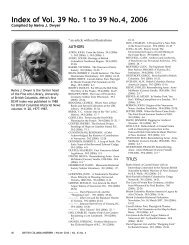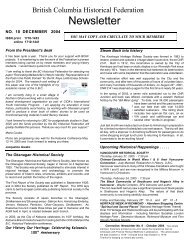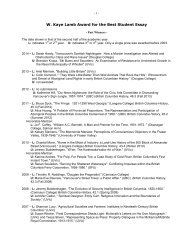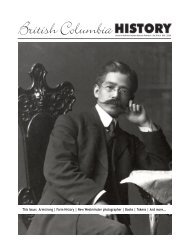bc historic news - BC Historical Federation
bc historic news - BC Historical Federation
bc historic news - BC Historical Federation
Create successful ePaper yourself
Turn your PDF publications into a flip-book with our unique Google optimized e-Paper software.
the rights and responsibilities of the position. Whileat North Walsham, he received a communication fromthe Reverend Robert Staines, documenting his voyageto Fort Victoria and the type of environment he foundthere. Staines must have considered Cridge a friendas he knew of his current address and ended hiscommunication with “My Dear Cridge”. 15 At thisjuncture, however, the Reverend Cridge was occupiedseeking a church of his own. Did he now have anavenue to better prospects?The young minister accepted a vacancy in theWest Ham parish just east of the growing juggernaut,London. Here, Edward met his future wife Marywhile both were visiting members of the congregation.After her father’s death in 1845, Mary, a self-assuredeighteen year old from Romford, Essex moved to WestHam Parish to fill a position as a Sunday schoolteacher. She had “black hair and dark blue eyes” anda slim figure with medium height.” 16 Later, when Dr.Helmcken first met them in Fort Victoria, he describedMrs. Cridge as a “nice, amiable, pretty-looking andslim young lady.” 17 West Ham Parish, Essex had fourchurches serving the growing population spilling overfrom London. The vicar ran the parish from All SaintsAnglican Church in West Ham village, assisted by hiscurate, the Reverend F.W. Davis. Just north of thevillage stood St. John’s Anglican Church, Stratford,served by incumbent the Reverend W. Holloway andcurate, the Reverend George Eastman, while St.Mary’s Anglican Church, Plaistow was presided overby incumbent the Reverend R.W.B. Marsh. Plaistowwas situated west of West Ham village on theRomford road. All the ministers and lay workers wereunder the supervision of the vicar the Reverend A.J.Ram. In 1852 the Reverend Edward Cridge becamethe incumbent at Christ Church covering the Marshdistrict. 18 This was the newest and the poorest churchin the parish.In 1853, while Cridge served Christ Church, hisbrother Richard passed away after a lingering illness.Both Edward and sister Mary came hurrying homejust in time for the funeral. The family had not beentogether for quite some time and Edward noticed hisfather was pale, drawn looking and very ill.Concerned, he uncovered his father’s financialproblems. He owed money on his property and hadbeen frequenting public houses regularly instead ofpaying his creditors. Edward’s problem was how tosave his father from going to prison and pay for hisown livelihood. He knew that his own income wouldnot provide the necessary funds and this problempreyed heavily on his mind. After arranging arepayment agreement on his father’s behalf, theReverend Cridge returned to West Ham Parish. Thevicar, the Reverend A.J. Ram and the Reverend F.W.Davies observed the dejected demeanour of Cridgeand, reasoning that the Marsh district was provingtoo heavy a burden for him, suggested he take a leaveof absence. Annoyed at such an interpretation, theReverend Cridge would not confide in them the actualreasons for his depression but hoped they would notplace his name for any vacancy. In commenting onCridge’s service presentations, the vicar felt that hissermons rambled too much, had a very strictCalvinistic message and that this was thinning thecongregation. This did not sit well with the ChristChurch minister, who proceeded to write a forcefulletter to the vicar explaining each of the criticismsbrought against him. The Reverend Cridge was selfopinionated, stubborn, and unable to accept criticismfrom superiors, yet he was deeply committed to hisfaith, had a logical mind and was hard working,characteristics that would serve him in good stead. Itwas also such characteristics that would play a majorrole in the division of the Anglican church in Victoriain the 1870s. Vicar Ram could see a need to have theReverend Cridge pass on to another position andseriously began to search for one for him. 19Although Cridge turned down severalsuggested vacancies, on August 30, 1854, the vicarinformed him of the vacancy for the Fort Victoriachaplain, the Reverend Robert J. Staines havingdrowned off Cape Flattery while returning toEngland. This position appeared to be the one forwhich Cridge had been waiting. His sent hisapplication to the Governor and Committee of theHudson’s Bay Company, Hudson’s Bay House,London, the very next day. 20 In it, he spelled out hisreasons for seeking the position, pledging not only towork for his “heavenly Father”, but also for the viewsof the Company, and “promoting the best interest ofthe colony.” The Company considered his referenescarefully and after some doubtful moments he wasofficially selected to fill the position on September 9,1854. 21 A memorandum accompanying the offer ofemployment spelled out the duties and remuneration;by signing and returning the contract, which requiredhim to be ready to sail by September 19, he made itlegally binding. The memorandum also suggestedhe should marry before he left. While waiting for theCompany to reply to his application, the ReverendCridge gained a great deal of information from men10. William Cockin (Oxford).Testimonial for Edward Cridge,December 11, 1841. (H<strong>BC</strong>A),A.10/36 fo. 213.11. George Jenyns (BottishamHall, near Cambridge).Testimonial for Edward Cridge,April 2, 1844. (H<strong>BC</strong>A) A.10/36 fo.199.12. The Church of England,Lambeth Palace Library, Englandto Robert G. Dennison, November28, 2003. Photocopies AlumniCantabrigienses, p. 179 andPeterhouse Admission Book, p.484.13. Norwich Records Office,Norwich, England to Robert G.Dennison, February 17, 2004.(Robert J. Staines ordaineddeacon August 20, 1848.Ordained priest, August 27,1848). Ordination register DN/ORR 4/2.14. Edward Cridge Diary, 1854.(<strong>BC</strong>A) MS 0320.15. Norwich Records Office toRobert G. Dennison, February 17,2004. Parish registers, 1847-1852 and curate licences DN/CUR14.16. G. Hollis Slater, “RobertJohn Staines: Pioneer Priest,Pedagogue, and PoliticalAgitator”. British Columbia<strong>Historical</strong> Quarterly 4 Vol. XIV,1950. p. 15. Staines wrote,“Hoping that we may still live tosee her shores again, and thatyou may live to meet us there”.17. N. de Bertrand Lugrin, ThePioneer Women of VancouverIsland, 1843-1866. (Victoria:Women’s Canadian Club ofVictoria, 1928), p. 28.18. Dorothy Blakey Smith (ed.),The Reminiscences of DoctorJohn Sebastian Helmcken.(Vancouver: University of BritishColumbia Press, 1975), p. 147.19. Lambeth Palace Library toRobert G. Dennison, November28, 2003. Photocopy: Crockford’sClerical Directory, 1853, p. 32(Hal-Han).BRITISH COLUMBIA HISTORY - Vol. 39 No. 1 7







